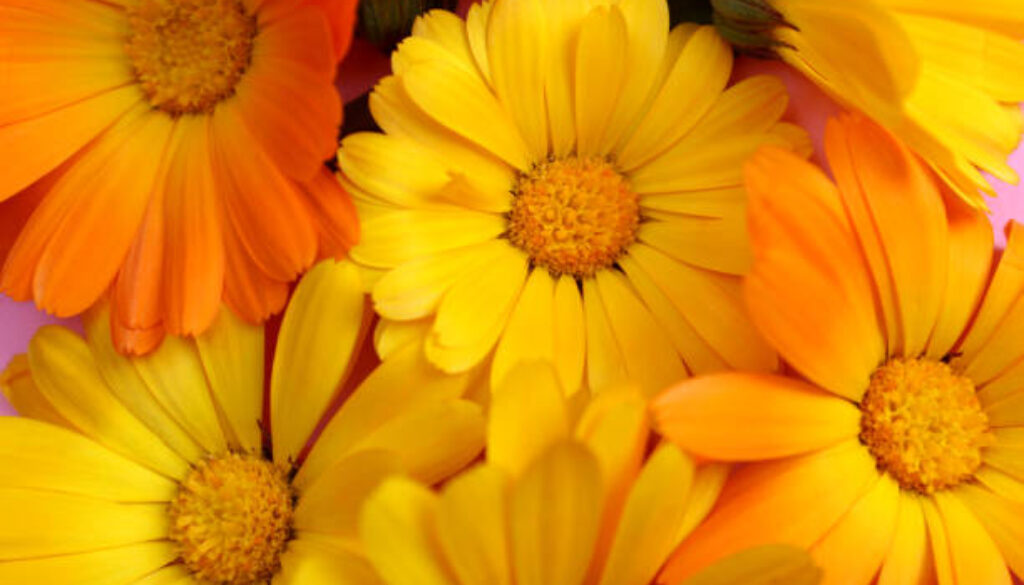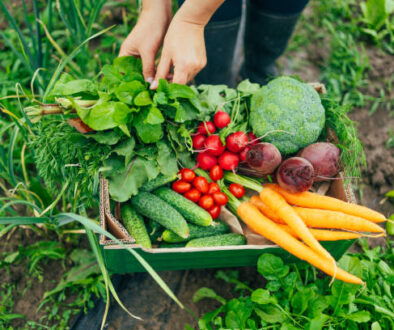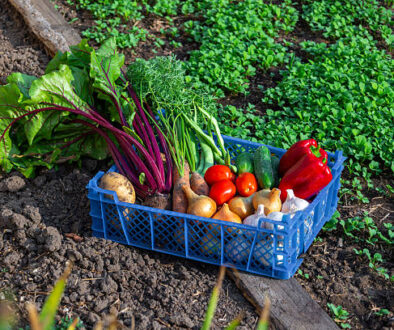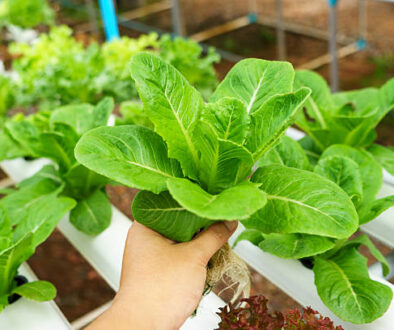Calendula – The Herb You Need to Keep Close During Dark Times
This post may contain paid and/or affiliate links. I may earn a small commission at no extra cost to you.
When life feels heavy, having the right plants around can make a real and big difference.
Calendula isn’t just a pretty flower, although it is, but it’s also a powerhouse you’ll want in your herbal medicine garden.
Its bright petals are known for soothing cuts, burns, and skin irritations, making it a must-have among healing plants.
If you’re tending a medical garden or maybe exploring garden companion planting, calendula is the kind of friend every gardener needs to keep nearby.
In this guide, I’ll show you why calendula deserves a spot in your garden and how it can support you through tough times.
Why Calendula is a Must-Have In Every Garden
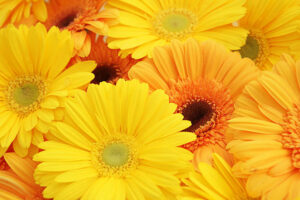
Calendula, also known as pot marigold, is one of those plants that’s simple to grow but packs a lot of punch.
Whether you’re a beginner or an experienced gardener, it’s a versatile addition to your garden.
Calendula thrives in both garden beds and containers, making it perfect for small spaces or larger medical gardens.
Its bright, golden-orange flowers don’t just look cheerful—they’re also edible and packed with natural compounds that help with inflammation, minor cuts, and skin irritations.
One of the reasons gardeners love calendula is how easy it is to care for.
It grows well in full sun and tolerates poor soil, though it prefers well-drained earth.
Water it regularly but avoid overwatering, and you’ll be rewarded with blooms from early spring until the first frost.
Unlike some herbs that demand a lot of attention, calendula is forgiving and will reward consistent care with beautiful flowers and therapeutic benefits.
Related:
- How to Start A Medicinal Garden at Home, Even if you’ve never planted anything before
- 14 Herbs That Grow Perfectly Well In Buckets Anytime Of The Year
- 9 Powerful Medicinal Herbs to Add to Your Healing Herbs Garden
Growing Calendula from Seeds
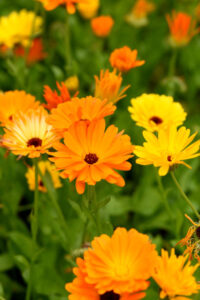
Starting calendula from seeds is straightforward, even if you’ve never grown a plant before.
Begin indoors 6-8 weeks before the last expected frost, or sow directly into your garden once the soil has warmed.
Lightly press the seeds into the soil—they need sunlight to germinate, so don’t cover them too deeply.
Keep the soil moist but not soggy, and within a week or two, you should see tiny green shoots appear.
Once your seedlings are strong enough, transplant them to your garden or containers.
Space them about 12 inches apart to allow for healthy growth and air circulation.
Calendula is a resilient plant, so even if a few seedlings don’t make it, others will likely thrive.
It’s a plant that really encourages patience—you’ll be surprised how quickly it fills in your garden with cheerful flowers.
Companion Planting with Calendula
Calendula isn’t just useful on its own—it’s fantastic as a companion plant.
It attracts beneficial insects like ladybugs and hoverflies that feed on pests such as aphids.
Planting calendula near tomatoes, peppers, or cucumbers can improve the overall health of your garden while reducing the need for chemical sprays.
Additionally, calendula flowers can improve soil health. When the petals fall and decompose, they enrich the soil with nutrients.
You can even plant calendula alongside herbs like basil or thyme; they tend to support each other and help prevent diseases from spreading.
For anyone looking to design a medicinal herbs garden, calendula is a smart choice because it multitasks beautifully: it’s pretty, practical, and protective.
Harvesting and Using Calendula
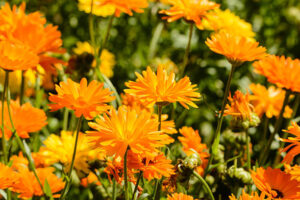
Harvesting calendula is easy, but timing matters. For the best potency, pick the flowers in the morning after the dew has dried.
You can use fresh petals directly in salads, teas, or infused oils.
Drying the flowers allows you to store them for later use in salves, tinctures, or soothing teas.
Calendula has long been used in traditional medicine for skin care.
Its anti-inflammatory and antimicrobial properties make it ideal for minor burns, cuts, rashes, or dry skin.
You can infuse it in oil to create homemade ointments or mix it with beeswax for salves.
Some people even add dried petals to bathwater for a calming, skin-soothing soak.
Its versatility makes it an essential plant in any medicinal herb garden.
Caring for Calendula Year-Round
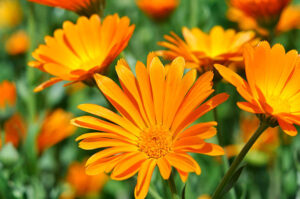
Calendula is a hardy plant, but a little attention ensures it thrives all year.
Deadheading spent flowers encourages new blooms and keeps the plant looking fresh.
While it tolerates a variety of soils, adding compost can boost flower production and overall plant health.
In colder climates, calendula often self-seeds, returning year after year.
If you live somewhere milder, it can bloom almost continuously, giving you a reliable source of medicinal flowers for months.
Regular watering and monitoring for pests like aphids or slugs will keep your plant strong and vibrant.
With minimal effort, calendula can become one of the most rewarding plants in your garden.
Why Calendula is a Must-Have in Dark Times
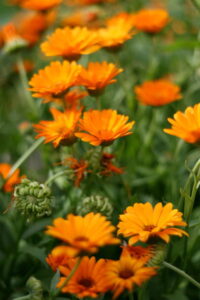
Beyond its practical uses, calendula has symbolic and emotional value.
Its bright, sunny petals can lift your mood and make your garden feel welcoming and alive.
When life gets stressful or overwhelming, tending to plants like calendula can provide a sense of calm and accomplishment.
The plant’s resilience mirrors what many of us strive for—strong, bright, and thriving despite challenges.
By growing calendula, you’re not just cultivating a plant; you’re creating a small, supportive environment that can improve both physical health and emotional well-being.
Conclusion
Calendula is more than just a flower—it’s a reliable, healing companion in your garden.
Easy to grow, useful in countless ways, and emotionally uplifting, it deserves a spot in every gardener’s space.
With a little care, it rewards you with beauty, medicinal properties, and a mood boost when you need it most.
FAQs
Q1: Can I grow calendula indoors?
Yes! Calendula does well in pots and containers indoors. Make sure it gets at least 4-6 hours of sunlight daily, and water it regularly without overwatering.
Q2: Are calendula petals safe to eat?
Absolutely. Fresh petals can be added to salads, teas, or even desserts. They’re mildly tangy and add a pop of color and nutrients.
Q3: How do I make calendula oil?
Fill a jar with dried or fresh calendula petals and cover with a neutral oil like olive or sunflower. Let it sit in sunlight for 2-4 weeks, shaking occasionally. Strain and use for skin care or healing salves.
Q4: Will calendula attract pests?
While it attracts beneficial insects, some pests like aphids may be drawn to it. Regular inspection and companion planting help keep pests in check naturally.
